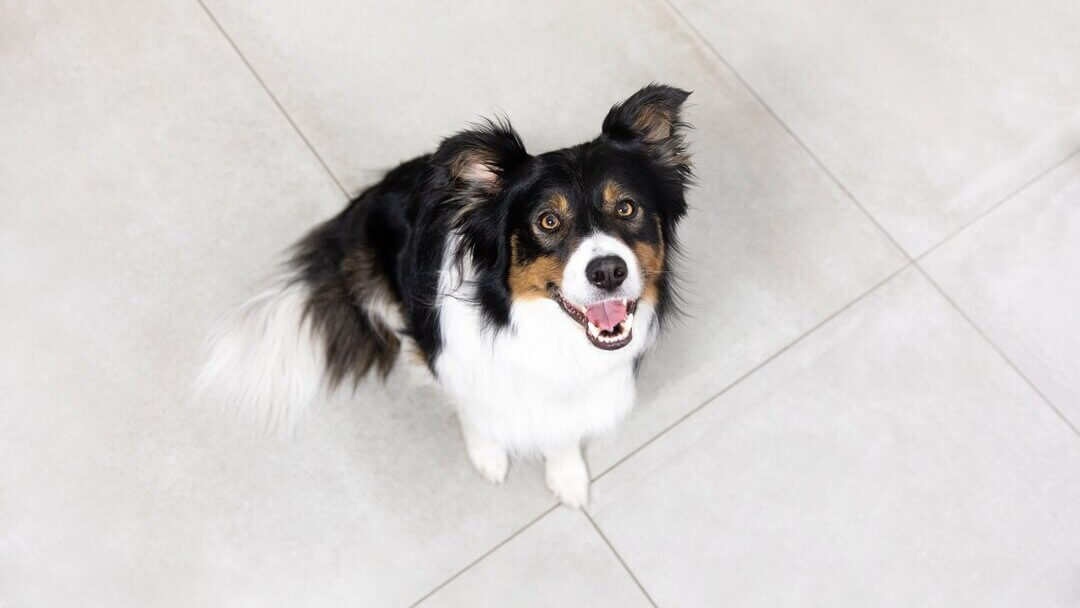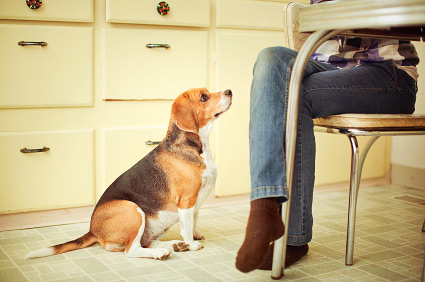If your old dog is standing and staring at you, it could be a sign of a medical issue, cognitive dysfunction, or simply seeking attention. It’s important to observe any changes in behavior and consult with a veterinarian to rule out any underlying health concerns.
Additionally, older dogs may experience changes in their senses, such as vision or hearing loss, which could impact their behavior. Providing a comfortable environment and engaging in regular mental and physical stimulation can help alleviate any cognitive issues and ensure your dog’s well-being.
Taking note of your dog’s needs and behavior is crucial in providing the best care for your loyal companion as they age.
The Aging Process Of Dogs
As our beloved dogs age, we often notice changes in their physical and behavioral traits. These changes are a natural part of the aging process, and it’s essential for pet owners to understand and adapt to these transformations to ensure their dog’s well-being and quality of life. In this section, we’ll explore the physical and behavioral changes that commonly occur as dogs grow older.
Physical Changes
Just like humans, dogs experience physical changes as they age. These changes can vary depending on the breed, size, and overall health of the dog. Some common physical signs of aging in dogs include:
- Decreased energy levels and exercise intolerance
- Weight gain or loss
- Changes in coat and skin condition, such as graying or thinning of the fur
- Loss of muscle mass and strength
- Deteriorating dental health
- Reduced sensory perception, including hearing and vision loss
It’s crucial to monitor and address these physical changes in older dogs. Regular vet check-ups, appropriate dietary adjustments, and providing a comfortable living environment can help manage these age-related issues.
Behavioral Changes
Alongside physical changes, dogs also exhibit behavioral changes as they age. These changes can be attributed to a combination of physical discomfort, cognitive decline, and adapting to their changing abilities. Some common behavioral changes in aging dogs include:
- Increased clinginess or separation anxiety
- Reduced activity and playfulness
- Sleeping more and becoming less active during the day
- Increased irritability or sensitivity to touch
- Increased frequency of accidents or difficulty with house-training
- Changes in appetite and eating habits
These behavioral changes can sometimes be challenging for dog owners, but patience, understanding, and providing appropriate mental and physical stimulation can help ease the transition for your aging furry friend.
Understanding and recognizing the physical and behavioral changes in an aging dog is crucial for ensuring their comfort and well-being. Consult with your veterinarian for personalized advice on how to manage and support your dog through the aging process.
Credit: www.businessinsider.com
Common Behavioral Changes In Old Dogs
As dogs age, they often undergo a variety of behavioral changes. Understanding these changes and how to support your aging pup is crucial for maintaining their quality of life and overall well-being. Some common behavioral changes in old dogs include:
Decreased Energy Levels
Older dogs may experience a noticeable decrease in energy levels as they age. This can manifest as reduced interest in playtime or a reluctance to engage in physical activities that they once enjoyed. It’s important to adapt their exercise routines and provide them with plenty of opportunities for rest and relaxation.
Increased Sleep
Another common behavioral change in older dogs is an increase in the amount of time spent sleeping. Older dogs may require more sleep to rest and recover from the physical toll of aging. Ensure they have a comfortable and quiet space to nap during the day and enjoy uninterrupted sleep at night.
Loss Of Interest In Activities
Older dogs might show a diminished interest in activities they previously loved, such as fetching a ball or going for long walks. Their declining physical abilities or discomfort may contribute to this change. Finding new ways to engage and stimulate your aging dog, such as gentle mental exercises or short, leisurely strolls, can help keep them active and happy.
Potential Reasons For A Dog Staring At Its Owner
Has your old dog been standing and staring at you a lot lately? It may seem puzzling, but there are several potential reasons why your furry friend is fixated on you. Understanding these reasons can help you deepen your bond and address any underlying concerns.
Bonding And Connection
Dogs are known for their loyalty, and staring at their owners can be a way to strengthen the bond between them. This direct gaze is often a display of trust and affection, indicating that your dog values your presence and enjoys the emotional connection with you.
Seeking Attention
When your dog stares at you, it may be seeking your attention. Perhaps it’s hoping for a play session, a belly rub, or simply some one-on-one interaction. By maintaining eye contact, your dog could be signaling its desire for engagement and social interaction.
Medical Concerns
It’s essential to consider the possibility of underlying medical issues when your dog exhibits unusual behavior, such as excessive staring. Monitoring your dog for any other symptoms along with the staring can help detect any potential health problems early on. A veterinarian evaluation is advisable if you suspect any medical concerns.
How To Respond To A Dog Staring At You
Is your old dog constantly staring at you? Discover effective ways to respond and engage with your furry companion to better understand their behavior and keep them happy.
It can be quite perplexing when your old dog stares at you without any apparent reason. As a pet owner, you may find yourself wondering why your faithful companion engages in this behavior. It’s important to understand that dogs communicate through various means, and staring is one of them. In this section, we will explore some effective ways to respond when your dog stares at you, ensuring a positive and engaging interaction.
Positive Reinforcement
When your dog stares at you, it could be seeking attention or even trying to communicate a need. One way to respond is through positive reinforcement. By acknowledging your dog’s behavior and rewarding it with praise, treats, or a gentle pat, you are reinforcing the bond between you and your furry friend. This positive reinforcement helps your dog understand that staring at you leads to positive outcomes, incentivizing them to repeat this behavior in the future.
Engaging In Interactive Activities
Another great way to respond to your dog’s staring is by engaging in interactive activities. Dogs thrive on mental and physical stimulation, so providing them with opportunities to exercise their mind and body can be both rewarding and enjoyable. You can play fetch, go for walks, or try out puzzle toys that challenge their problem-solving skills. These activities not only divert their attention but also strengthen the bond between you and your furry companion.
Seeking Veterinary Advice
In certain cases, persistent staring might be a sign of underlying health issues. If you notice any abnormal changes in your dog’s behavior, such as prolonged and intense staring accompanied by other symptoms like lethargy or loss of appetite, it’s crucial to seek veterinary advice. A veterinarian can conduct a thorough examination and determine if there are any underlying medical conditions contributing to this behavior. Remember, your dog’s health and well-being should always be a top priority.
By understanding and responding appropriately to your dog’s staring, you can strengthen your bond with them and ensure their overall well-being. Remember, positive reinforcement, engaging in interactive activities, and seeking veterinary advice are essential aspects of responding to your dog’s staring behavior. By implementing these strategies, you can navigate this mysterious behavior with confidence and create a happy and harmonious environment for both you and your furry friend.
Caring For An Aging Dog
Caring for an aging dog can be challenging, especially when they just stand and stare at you. It’s important to provide them with comfort, attention, and regular vet check-ups to ensure their well-being and happiness. Take the time to understand their needs and make adjustments to their environment as necessary.
Regular Veterinary Check-ups
Regular veterinary check-ups are crucial when it comes to caring for an aging dog. Just like humans, dogs can experience age-related health issues, and early detection is key to ensuring they receive the proper care and treatment they need. By scheduling regular check-ups with your vet, you can stay on top of your old dog’s health and address any potential issues before they worsen. These check-ups typically include a thorough examination, blood tests, and screenings for conditions common in aging dogs, such as arthritis, heart disease, or diabetes. Your vet may also provide recommendations for a healthy diet, supplements, or medication to support your dog’s overall well-being.
Providing A Comfortable Environment
As your dog ages, it’s important to provide a comfortable environment that caters to their changing needs. This means ensuring their living space is warm and cozy, free from drafts and extreme temperatures. Providing a soft bed or blankets can help alleviate joint pain and provide a warm spot to rest. If your old dog has difficulty navigating stairs or getting in and out of the car, consider placing ramps or steps to assist them. Additionally, make sure their water and food bowls are easily accessible, and consider using elevated bowls to reduce strain on their neck and joints. Creating a safe and comfortable environment will contribute to your aging dog’s overall well-being and quality of life.
Adapting The Exercise Routine
Exercise plays a vital role in maintaining your aging dog’s physical and mental health. However, as they get older, their exercise needs may change. It’s essential to adapt their exercise routine to match their capabilities and health state. While regular exercise is still important, it’s crucial to avoid overexertion or high-impact activities that can strain their aging joints and muscles. Instead, focus on low-impact exercises such as short walks, gentle play sessions, or swimming. Take into account their breed, size, and any pre-existing health conditions, and consult with your vet to determine the most suitable exercise regimen for your old dog. Remember, consistency is key, and providing regular, appropriate exercise will help keep them happy, healthy, and enjoying their golden years.

Credit: wagsandwiggles.com

Credit: www.purina.co.uk
Frequently Asked Questions For My Old Dog Just Stands And Stares At Me
Why Does My Old Dog Stand And Stare At Me?
Old dogs may stand and stare at their owners due to various reasons, including sensory decline, cognitive changes, or discomfort. It can be their way of seeking attention, expressing affection, or simply observing their surroundings. If you notice any concerning behavior, it’s best to consult a veterinarian for a proper diagnosis and guidance.
Conclusion
Our old dogs have a special way of communicating with us, even without barking or wagging their tails. When they stand and stare at us, it may be their way of expressing love, trust, or even a plea for attention.
Understanding their behaviors deepens our bond and helps us respond appropriately to their needs. So, the next time your old dog stands and stares at you, embrace the moment and cherish the unspoken connection you share.



